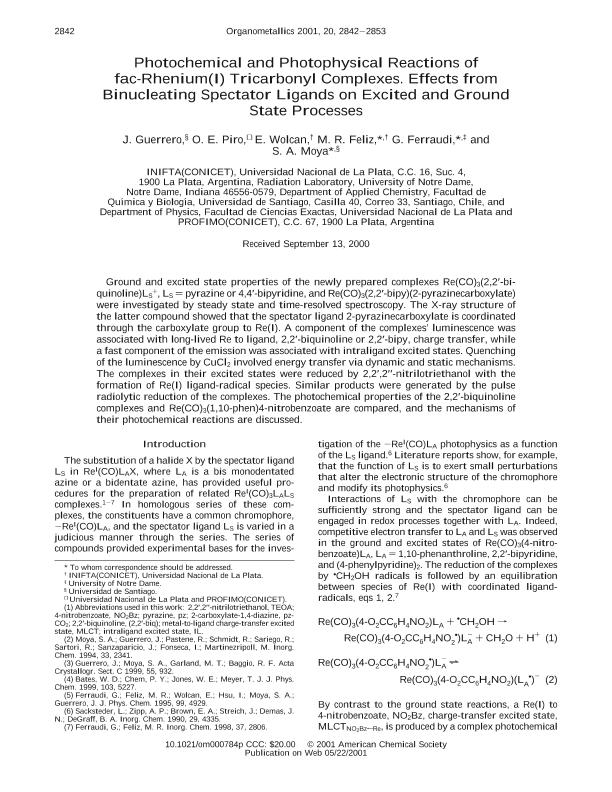Mostrar el registro sencillo del ítem
dc.contributor.author
Guerrero, J.
dc.contributor.author
Piro, Oscar Enrique

dc.contributor.author
Wolcan, Ezequiel

dc.contributor.author
Feliz, Mario Ruben

dc.contributor.author
Ferraudi, G.
dc.contributor.author
Moya, S. A.
dc.date.available
2020-02-19T16:44:40Z
dc.date.issued
2001-12
dc.identifier.citation
Guerrero, J.; Piro, Oscar Enrique; Wolcan, Ezequiel; Feliz, Mario Ruben; Ferraudi, G.; et al.; Photochemical and Photophysical Reactions of f ac -Rhenium(I) Tricarbonyl Complexes. Effects from Binucleating Spectator Ligands on Excited and Ground State Processes; American Chemical Society; Organometallics; 20; 13; 12-2001; 2842-2853
dc.identifier.issn
0276-7333
dc.identifier.uri
http://hdl.handle.net/11336/98029
dc.description.abstract
Ground and excited state properties of the newly prepared complexes Re(CO)3(2,2¢-biquinoline) LS3(2,2¢-biquinoline) LSS +, LS ) pyrazine or 4,4¢-bipyridine, and Re(CO)3(2,2¢-bipy)(2-pyrazinecarboxylate) were investigated by steady state and time-resolved spectroscopy. The X-ray structure of the latter compound showed that the spectator ligand 2-pyrazinecarboxylate is coordinated through the carboxylate group to Re(I). A component of the complexes’ luminescence was associated with long-lived Re to ligand, 2,2¢-biquinoline or 2,2¢-bipy, charge transfer, while a fast component of the emission was associated with intraligand excited states. Quenching of the luminescence by CuCl2 involved energy transfer via dynamic and static mechanisms. The complexes in their excited states were reduced by 2,2¢,2¢¢-nitrilotriethanol with the formation of Re(I) ligand-radical species. Similar products were generated by the pulse radiolytic reduction of the complexes. The photochemical properties of the 2,2¢-biquinoline complexes and Re(CO)3(1,10-phen)4-nitrobenzoate are compared, and the mechanisms of their photochemical reactions are discussed., LS ) pyrazine or 4,4¢-bipyridine, and Re(CO)3(2,2¢-bipy)(2-pyrazinecarboxylate) were investigated by steady state and time-resolved spectroscopy. The X-ray structure of the latter compound showed that the spectator ligand 2-pyrazinecarboxylate is coordinated through the carboxylate group to Re(I). A component of the complexes’ luminescence was associated with long-lived Re to ligand, 2,2¢-biquinoline or 2,2¢-bipy, charge transfer, while a fast component of the emission was associated with intraligand excited states. Quenching of the luminescence by CuCl2 involved energy transfer via dynamic and static mechanisms. The complexes in their excited states were reduced by 2,2¢,2¢¢-nitrilotriethanol with the formation of Re(I) ligand-radical species. Similar products were generated by the pulse radiolytic reduction of the complexes. The photochemical properties of the 2,2¢-biquinoline complexes and Re(CO)3(1,10-phen)4-nitrobenzoate are compared, and the mechanisms of their photochemical reactions are discussed.¢-biquinoline or 2,2¢-bipy, charge transfer, while a fast component of the emission was associated with intraligand excited states. Quenching of the luminescence by CuCl2 involved energy transfer via dynamic and static mechanisms. The complexes in their excited states were reduced by 2,2¢,2¢¢-nitrilotriethanol with the formation of Re(I) ligand-radical species. Similar products were generated by the pulse radiolytic reduction of the complexes. The photochemical properties of the 2,2¢-biquinoline complexes and Re(CO)3(1,10-phen)4-nitrobenzoate are compared, and the mechanisms of their photochemical reactions are discussed.2 involved energy transfer via dynamic and static mechanisms. The complexes in their excited states were reduced by 2,2¢,2¢¢-nitrilotriethanol with the formation of Re(I) ligand-radical species. Similar products were generated by the pulse radiolytic reduction of the complexes. The photochemical properties of the 2,2¢-biquinoline complexes and Re(CO)3(1,10-phen)4-nitrobenzoate are compared, and the mechanisms of their photochemical reactions are discussed.¢,2¢¢-nitrilotriethanol with the formation of Re(I) ligand-radical species. Similar products were generated by the pulse radiolytic reduction of the complexes. The photochemical properties of the 2,2¢-biquinoline complexes and Re(CO)3(1,10-phen)4-nitrobenzoate are compared, and the mechanisms of their photochemical reactions are discussed.¢-biquinoline complexes and Re(CO)3(1,10-phen)4-nitrobenzoate are compared, and the mechanisms of their photochemical reactions are discussed.3(1,10-phen)4-nitrobenzoate are compared, and the mechanisms of their photochemical reactions are discussed.
dc.format
application/pdf
dc.language.iso
eng
dc.publisher
American Chemical Society

dc.rights
info:eu-repo/semantics/openAccess
dc.rights.uri
https://creativecommons.org/licenses/by-nc-sa/2.5/ar/
dc.subject.classification
Físico-Química, Ciencia de los Polímeros, Electroquímica

dc.subject.classification
Ciencias Químicas

dc.subject.classification
CIENCIAS NATURALES Y EXACTAS

dc.title
Photochemical and Photophysical Reactions of f ac -Rhenium(I) Tricarbonyl Complexes. Effects from Binucleating Spectator Ligands on Excited and Ground State Processes
dc.type
info:eu-repo/semantics/article
dc.type
info:ar-repo/semantics/artículo
dc.type
info:eu-repo/semantics/publishedVersion
dc.date.updated
2020-02-10T14:07:28Z
dc.journal.volume
20
dc.journal.number
13
dc.journal.pagination
2842-2853
dc.journal.pais
Estados Unidos

dc.description.fil
Fil: Guerrero, J.. Universidad de Santiago de Chile; Chile
dc.description.fil
Fil: Piro, Oscar Enrique. Consejo Nacional de Investigaciones Científicas y Técnicas. Centro Científico Tecnológico Conicet - La Plata. Instituto de Física La Plata. Universidad Nacional de La Plata. Facultad de Ciencias Exactas. Instituto de Física La Plata; Argentina. Universidad Nacional de La Plata; Argentina
dc.description.fil
Fil: Wolcan, Ezequiel. Consejo Nacional de Investigaciones Científicas y Técnicas. Centro Científico Tecnológico Conicet - La Plata. Instituto de Investigaciones Fisicoquímicas Teóricas y Aplicadas. Universidad Nacional de La Plata. Facultad de Ciencias Exactas. Instituto de Investigaciones Fisicoquímicas Teóricas y Aplicadas; Argentina
dc.description.fil
Fil: Feliz, Mario Ruben. Consejo Nacional de Investigaciones Científicas y Técnicas. Centro Científico Tecnológico Conicet - La Plata. Instituto de Investigaciones Fisicoquímicas Teóricas y Aplicadas. Universidad Nacional de La Plata. Facultad de Ciencias Exactas. Instituto de Investigaciones Fisicoquímicas Teóricas y Aplicadas; Argentina
dc.description.fil
Fil: Ferraudi, G.. University of Notre Dame; Estados Unidos
dc.description.fil
Fil: Moya, S. A.. Universidad de Santiago de Chile; Chile
dc.journal.title
Organometallics

dc.relation.alternativeid
info:eu-repo/semantics/altIdentifier/doi/http://dx.doi.org/10.1021/om000784p
dc.relation.alternativeid
info:eu-repo/semantics/altIdentifier/url/https://pubs.acs.org/doi/abs/10.1021/om000784p
Archivos asociados
